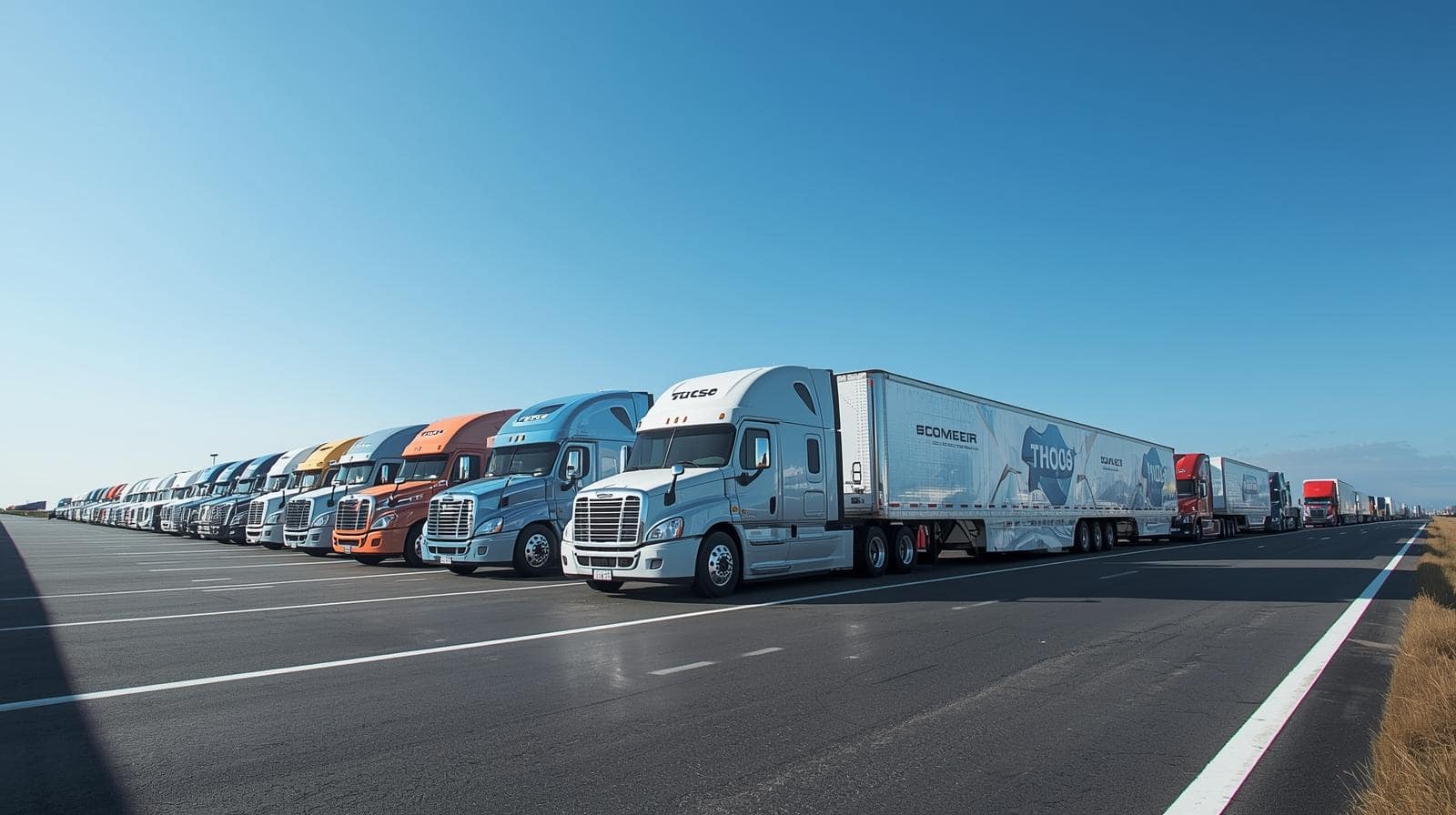In the trucking industry, fuel costs are one of the most significant expenses. Whether you’re an owner-operator or manage a fleet, optimizing your trucking fuel economy is essential for cutting operational costs and maximizing profits. Understanding how to improve your truck’s MPG (miles per gallon) can help you reduce fuel consumption, increase your bottom line, and lessen your environmental footprint. In this article, we will explore the MPG of a truck, tips for commercial vehicle fuel efficiency, and effective strategies to boost fuel economy across different truck types, including semi-trucks.
What Is the MPG of a Truck?
Before diving into how to optimize your trucking fuel economy, it’s crucial to understand what MPG means and how it relates to trucks. MPG, or miles per gallon, measures how efficiently a vehicle uses fuel. In the trucking industry, MPG is a critical metric because it directly impacts the cost of fuel for long-haul drivers and fleet owners.
The Average Trucking MPG
The average trucking MPG can vary greatly depending on several factors, including the type of truck, its weight, cargo load, driving conditions, and maintenance. For example, a standard commercial truck typically achieves around 6 to 8 MPG, while fuel efficiency in semi-trucks usually ranges between 5 and 6 MPG. These numbers can fluctuate based on road conditions, engine performance, and how well the truck is maintained.
However, improving the trucking MPG is a goal for many fleet managers and drivers, as a higher MPG translates into less fuel consumption and more cost savings. By paying attention to the various factors affecting trucking fuel economy, you can implement strategies to increase the MPG of a truck.
Factors Affecting MPG of a Truck
Several factors can influence the MPG of a truck, including:
- Engine type and size: Larger engines typically consume more fuel, but modern engine technologies can improve efficiency.
- Truck weight: Heavier trucks require more fuel to move, especially when fully loaded.
- Driving habits: Aggressive driving, including speeding, hard braking, and rapid acceleration, decreases fuel efficiency.
- Route and terrain: Long uphill climbs or driving in stop-and-go traffic can reduce MPG.
- Aerodynamics: Trucks with better aerodynamics, such as streamlined designs and accessories like side skirts and trailer tails, tend to have higher fuel efficiency.
Improving trucking fuel economy starts with understanding these factors and focusing on areas where you can make the most significant impact.
Commercial Vehicle Fuel Efficiency
Commercial vehicle fuel efficiency is a crucial consideration for fleet owners and operators. As fuel prices continue to rise, maintaining high fuel efficiency in commercial vehicles not only improves profitability but also promotes sustainability by reducing carbon emissions. Let’s take a look at how commercial vehicles, including delivery trucks, box trucks, and semi-trucks, can improve fuel efficiency.
The Importance of Commercial Vehicle Fuel Efficiency
Efficient fuel usage is essential for any business relying on transportation. Poor fuel economy can significantly affect operational costs, leading to reduced profit margins and making it harder to stay competitive. On the other hand, optimizing commercial vehicle fuel efficiency can offer numerous benefits:
- Cost savings: Reducing fuel consumption helps lower overall fuel costs, which can represent a significant portion of a fleet’s operational budget.
- Increased fleet performance: Improving fuel efficiency means your fleet will be able to travel longer distances on less fuel, increasing productivity and reducing downtime.
- Environmental benefits: Lower fuel consumption means fewer emissions, contributing to a cleaner environment and helping to meet increasingly stringent environmental regulations.
Best Practices for Improving Commercial Vehicle Fuel Efficiency
To achieve optimal commercial vehicle fuel efficiency, fleet managers should focus on a combination of proper maintenance, smart driving practices, and technology solutions:
- Regular maintenance: Keeping engines in good working condition by performing regular maintenance, such as oil changes, tire checks, and air filter replacements, ensures optimal fuel performance.
- Driver training: Encouraging safe and fuel-efficient driving practices can significantly reduce fuel consumption. This includes avoiding rapid acceleration, idling for extended periods, and maintaining a steady speed.
- Fuel-efficient vehicles: When purchasing new trucks, consider fuel-efficient models with lower fuel consumption and improved aerodynamics.
- Telematics: Using telematics systems, such as Ezlogz, helps track driving behavior and monitor fuel usage in real-time, providing valuable insights into how to improve fuel efficiency.
How to Increase MPG on Truck
To increase MPG on truck is essential for reducing fuel expenses and ensuring your vehicle runs at peak performance. While achieving significant improvements requires ongoing effort, several steps can help you achieve noticeable gains in trucking fuel economy.
1. Optimize Tire Pressure
One of the easiest and most effective ways to increase MPG on your truck is to regularly check and maintain tire pressure. Under-inflated tires create more rolling resistance, causing your truck’s engine to work harder and consume more fuel. Keeping tires properly inflated reduces fuel consumption and ensures a smoother ride, extending tire life.
2. Maintain a Steady Speed
Maintaining a constant speed without frequent acceleration and braking is crucial for improving fuel economy. Sudden accelerations and braking waste fuel and decrease efficiency. On highways, cruise control is a helpful tool to maintain a steady speed and save on fuel.
3. Reduce Weight
The more weight your truck carries, the more fuel it will consume. Reducing unnecessary weight by removing excess cargo or non-essential equipment from the truck can have a significant impact on fuel efficiency. Additionally, lightweight materials in the truck body and trailer can improve overall MPG.
4. Utilize Aerodynamic Upgrades
The aerodynamics of your truck play a vital role in fuel efficiency, especially when driving at high speeds. Installing aerodynamic features like trailer skirts, side deflectors, and air dams reduces air resistance, improving fuel economy and reducing drag.
5. Plan Efficient Routes
Efficient route planning can reduce fuel consumption by avoiding traffic, construction zones, or areas with frequent stops. Leveraging GPS systems and route optimization software helps identify the quickest and least fuel-consuming routes, saving time and money.
How to Improve Gas Mileage on a Truck
To improve gas mileage on a truck can be achieved by taking a holistic approach that includes vehicle maintenance, driving habits, and technology adoption. Let’s dive deeper into the steps you can take to improve gas mileage on your truck.
1. Perform Regular Engine Maintenance
A well-maintained engine performs more efficiently and consumes less fuel. Regularly check the engine oil, fuel filters, and spark plugs to ensure they are in optimal condition. Replacing worn-out components and using high-quality oil can improve engine performance and fuel efficiency.
2. Use High-Quality Fuel
The type of fuel you use can impact the gas mileage on your truck. Opt for high-quality fuel and ensure that the fuel you purchase is appropriate for your truck’s engine. Using fuel with the proper additives or cleaner fuel can prevent build-up in the engine, allowing for better performance and improved mileage.
3. Avoid Excessive Idling
Idling wastes fuel without any productive use. If you’re waiting for an extended period, turn off the engine to conserve fuel. This simple habit can lead to significant fuel savings, especially over time.
4. Improve Driver Behavior
Driver habits play a significant role in gas mileage. Encourage drivers to adopt smooth driving techniques, such as gradual acceleration and deceleration. Avoiding heavy braking and using engine braking on downhill slopes also contributes to better fuel efficiency.
5. Invest in Fuel-Efficient Tires
Fuel-efficient tires are designed to reduce rolling resistance and improve fuel economy. These tires may cost more upfront, but they pay off in the long run by reducing fuel consumption.
Semi Truck Fuel Economy
Semi trucks, being the backbone of the freight industry, account for a significant portion of fuel consumption in the transportation sector. Fuel efficiency in semi trucks is crucial not only for cost savings but also for meeting sustainability goals and reducing emissions.
Challenges to Semi Truck Fuel Economy
Semi truck fuel economy can be impacted by various factors, including the truck’s weight, aerodynamics, engine type, and driving conditions. These trucks often carry heavy loads, which can decrease fuel efficiency compared to smaller vehicles. Additionally, the long-distance driving typical of semi-truck operations means that fuel efficiency improvements can result in considerable cost savings.
Strategies to Improve Semi Truck Fuel Economy
Improving semi truck fuel economy involves similar principles as other trucks, but with additional focus on weight management and aerodynamics:
- Weight reduction: Reducing the weight of the cargo and truck components can improve fuel economy. Use lighter materials when possible and avoid carrying unnecessary loads.
- Aerodynamic enhancements: Semi trucks benefit greatly from aerodynamic upgrades, such as trailer skirts, rear fairings, and streamlined truck designs.
- Speed management: Limiting the truck’s speed to optimal levels (usually around 65-70 mph) can help reduce fuel consumption without compromising delivery times.
- Engine optimization: Invest in modern, fuel-efficient engines designed specifically for long-haul trucking, which can offer better fuel economy over time.
By focusing on these areas, semi-truck owners and fleet operators can significantly improve fuel economy, leading to lower fuel costs and higher profits.
Trucking fuel economy is crucial for both long-term cost savings and environmental sustainability. By understanding how the MPG of a truck works, focusing on commercial vehicle fuel efficiency, and implementing strategies to improve gas mileage, you can significantly reduce your fuel expenses. Whether you operate a fleet of commercial vehicles or a single semi truck, the tips provided in this article can help boost your truck’s fuel economy and save on fuel costs.
At Ezlogz, we understand the challenges you face in optimizing trucking fuel economy. Our innovative fleet management solutions, including real-time monitoring and route optimization tools, can help you achieve better fuel efficiency, reduce costs, and enhance overall fleet performance. Contact Ezlogz today to learn more about how we can support your fuel efficiency goals.










